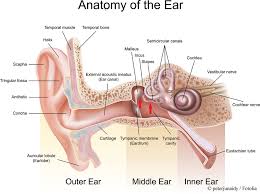The human ear is a complex organ that helps us hear and maintain balance. It is divided into three main parts: the outer ear, middle ear, and inner ear. Each part plays a specific role in the process of hearing.
1. Outer Ear:
- Pinna (Auricle): The visible, external part of the ear. Its shape helps capture sound waves from the environment and directs them into the ear canal.
- Ear Canal (External Auditory Meatus): A tube-like structure that channels sound waves from the pinna to the eardrum (tympanic membrane).
- Tympanic Membrane (Eardrum): A thin membrane at the end of the ear canal. It vibrates when sound waves hit it, converting the sound energy into mechanical vibrations.
2. Middle Ear:
- Ossicles (Ear Bones): Three small bones – the malleus (hammer), incus (anvil), and stapes (stirrup) – are located in the middle ear. These bones amplify the vibrations from the eardrum and transmit them to the inner ear.
- Malleus: Attached to the eardrum and vibrates first.
- Incus: Receives vibrations from the malleus and passes them to the stapes.
- Stapes: The smallest bone in the human body. It transmits vibrations to the inner ear, specifically to the oval window (a membrane-covered opening to the inner ear).
- Eustachian Tube: A narrow tube that connects the middle ear to the throat. It helps equalize air pressure on both sides of the eardrum, ensuring proper vibration.
3. Inner Ear:
- Cochlea: A spiral-shaped, fluid-filled structure. When sound vibrations from the stapes reach the oval window, they create pressure waves in the fluid of the cochlea. The cochlea is lined with tiny hair cells that convert these fluid waves into electrical signals.
- Hair Cells: Inside the cochlea, these specialized cells bend in response to fluid movement. The bending of hair cells triggers electrical signals, which are sent to the brain via the auditory nerve.
- Auditory Nerve: This nerve transmits the electrical signals from the hair cells to the brain, which then interprets them as sound.
- Vestibular System: Part of the inner ear, responsible for balance. It consists of semicircular canals and otolith organs that detect head position and motion, sending information to the brain.

How Sound is Heard:
- Sound Waves Enter: Sound waves from the environment are captured by the pinna and travel down the ear canal.
- Vibrating Eardrum: The sound waves hit the eardrum, causing it to vibrate. The eardrum’s vibration is proportional to the frequency and intensity of the sound.
- Amplification in Middle Ear: The vibrations are transmitted through the ossicles, amplifying them as they move through the middle ear.
- Transmission to Inner Ear: The stapes transmits the vibrations to the oval window, which sets the fluid in the cochlea into motion.
- Conversion to Electrical Signals: The movement of fluid in the cochlea causes the hair cells to bend. This bending generates electrical signals.
- Signal Processing in the Brain: The electrical signals are sent through the auditory nerve to the brain, where they are processed and interpreted as sound.